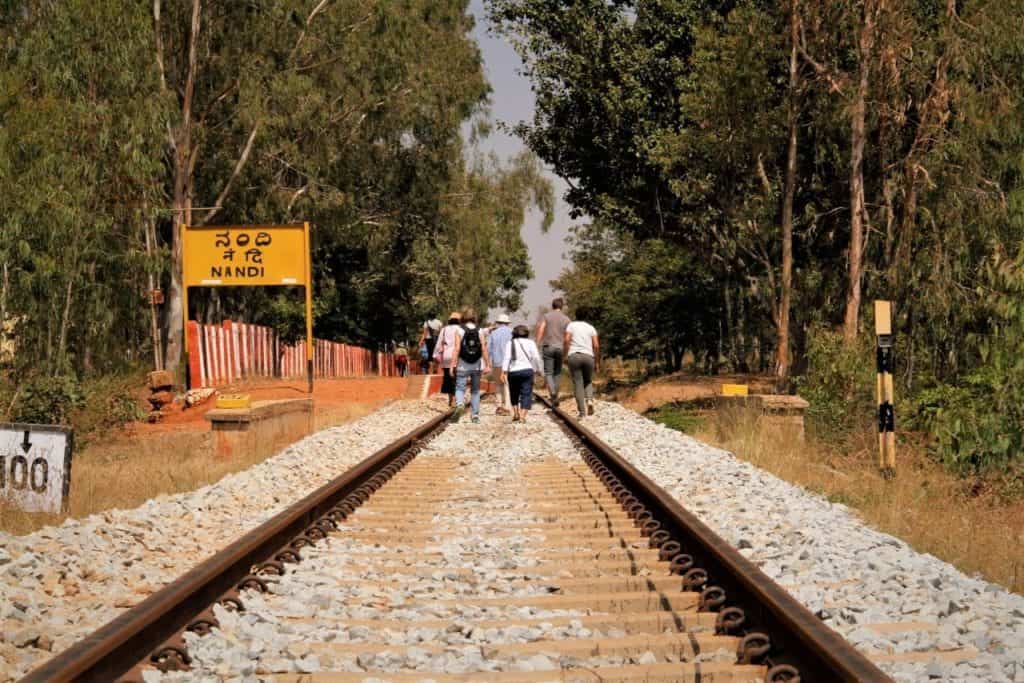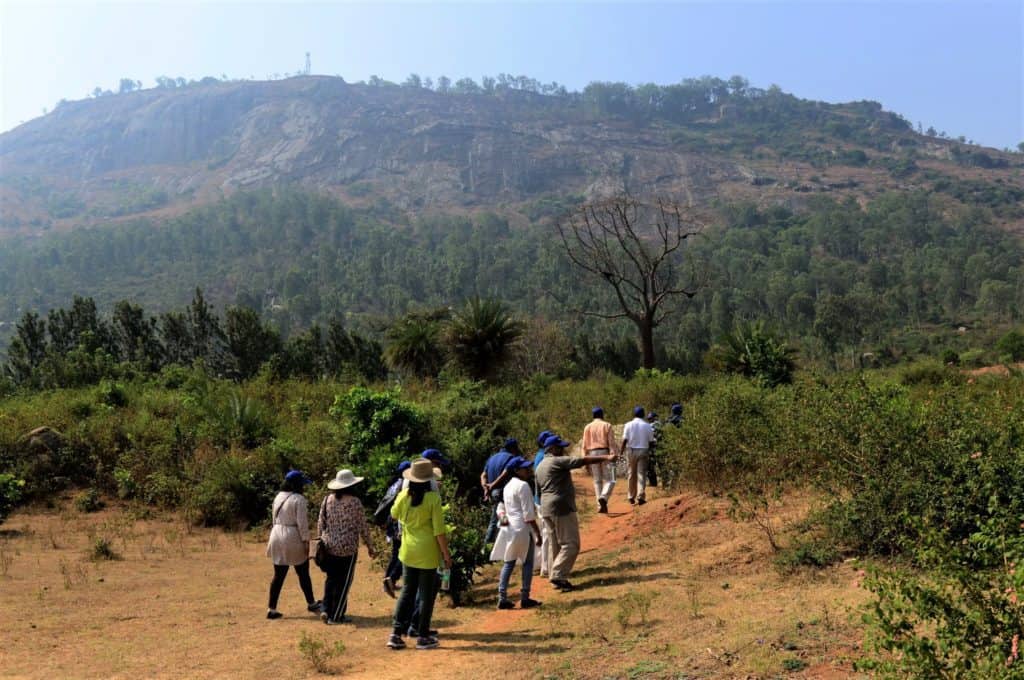On February 25, 2021, plans were announced from the highest levels of the state government to comprehensively develop Nandi Hills as an international tourist destination. This is to be done through various measures including a clean-up of the area, refurbishment of various structures and heritage sites, enlargement/improvement of the parking areas, and last but not the least, a ropeway to the summit.
My family and I moved home from the heart of Bengaluru to the foothills of Nandi Hills over seven years ago. The contrast in our altered lifestyles could not have been starker.
Swapping traffic noise for bird song
We swapped noisy, traffic-choked congestion, poor air quality, broken streets, filthy surroundings, and cramped common spaces, for the Bengaluru I knew as a child — lots of open spaces, plenty of greenery, an abundance of crisp clean air, and the two things that are worth yearning for: hearing the silence (with bird song and quarrels of sparrows) and seeing the night sky (the misty milky way and Saturn’s awesome rings). Living through the times of COVID has been more than a good reason for nay-sayers to keep silent.
Read more: “Comprehensive Mobility Plan ignores environmental impacts, sustainable solutions”
This then is home, which we share with a local community that, in the beginning, considered us outsiders. After all, who are we but a transient few traipsing across land and milieu steeped in history and tradition, with generations of families having lived and toiled on the very land that we too were now calling home?
But gradually, over these past seven years, we have been largely accepted in the community as fellow neighbours, although I’d be lying if I didn’t say that acceptance is a two-way street. The dividing lines of class and caste, silently pencilled in mutually in our very ethos, remain.
I therefore wince when announcement after announcement from the government — and there have been several over the past few years — focuses on Nandi Hills as a ‘tourist’ destination.
How would you feel if the principal lens through which your locality’s upkeep is viewed, is that of an outsider’s, looking in as a tourist? Wouldn’t you feel like zoo animals, cubby-holed purely for tourism’s consumption?
Alienation from home
Here lies the foundational problem with all these ‘development’ plans for Nandi Hills — deeply flawed because at their root, there is neither sufficient consultation with the local community (howsoever defined) nor adequate balancing between the objectives of ‘external’ tourism and the interests of ‘internal’ stakeholders. I juxtapose these to highlight the issue, not to suggest that ‘insiders’ cannot be tourists in their own locality, city or country.
Read more: Who should govern Bengaluru’s lakes — the government or the community? Or both?
I must hasten to add that not all parameters between these objectives and interests are opposed to one another. For instance, there can be no truck against a clean and garbage-free Nandi Hills.
However, simplistic solutions that amount to eyewash must be eschewed. Addressing tourism’s malaise of a garbage strewn area (by say, a clean-up drive now and then), serves neither any longer-term purpose (garbage will return) nor tackles the chief causes of the situation.
No one as far as is demonstrable, in government and in the State’s bureaucracy, has drilled down to the principal causes for today’s plastic-ridden Nandi Hills. I venture to suggest the principal issue — non-biodegradable, solid waste generation, management and treatment (which far outstrips tourism’s garbage bug-bear), and which is of mounting concern and threat to the local community. It is polluting the area, seeping into our water bodies and entering the human food chain.
It is trite to say that this issue needs to be tackled holistically, largely to address the local population’s safety and health, and thereby incidentally, solve tourism’s angst.
Allied to this issue is the abysmal lack of any real facilities in the area — as merely an example: how many clean and usable toilets does the area have?
Myopic transport and infrastructure plans
Transport is another area demonstrating the State’s myopic approach to Nandi Hills. Again I believe, no real thought has been given, nor any genuine analysis made, of the core problem. Providing for more parking spaces is like offering feed to pigeons. Their numbers (i.e., vehicles of all types) will only burgeon, needing more ‘feed’, i.e., more roads and parking space. Existing vehicular parking facilities must of course be upgraded, in some cases, properly completed where partly done. This is hiding in plain sight.
The sight of traffic jams leading to the hill-top shows an abject failure of governance that cannot be solved by additional parking lots. It is more than crystal clear that only a concentrated effort at a comprehensive/integrated public-private transport system and infrastructure policy can help solve Nandi Hills’ traffic problem. There has been some talk of electric vehicles or buses easing the burden — again a short term ‘band-aid’ approach, without an overall plan.
Several decades ago, I’ve heard it being said, that people travelled by train from Bengaluru to the Nandi Halt train station and then ‘motored’ up (in the quaint language of yesteryears) to the top of Nandi Hills.
Here again, illustratively, has anyone in the administration even considered multi-modal transport systems (car in city, to train to Nandi Halt, to bus to the hill-top, for example) in the area?

The much-touted ropeway is a terrible idea. The Government has reportedly had a preliminary report for clearance for several years (although all announcements are decidedly frugal on the details). I have represented over the years in this regard to many different officers, ministers and committees, from the then Member of Parliament downwards, anyone in authority who would care to listen to me.
The ropeway is the worst pound of tourism flesh, catering only to those who wish to get to the summit in the most expensive way, in terms of its construction and maintenance costs.
Where ecology meets history
Can those in authority please wake-up and acknowledge that Nandi Hills is an ecologically, environmentally, historically and culturally rich heritage precinct, covering not just the hill-top, but four other subsidiary hills, as well as the Nandi Valley? Arundhati Nag called it “from the foothills to the hill-top”.
Tourism’s biggest draw, the hill-top, must not be allowed to trump an overall, integrated, multi-modal transport plan I’ve addressed above, encapsulating the region as a whole.
From any direction one looks, access to the top of Nandi Hills traverses through forests that are the last remaining habitats in the area for leopards and bears. No surprise therefore that the Forest Department has never been keen on the ropeway project.

At different times, different people in government indicate different locations for this ropeway. For the longest time, it was to be on the south-eastern side, through one small section. That building the ropeway here would mean obliterating proper views of the Tipu’s Drop and Wellington’s Nose — or worse still damage these historically significant features — was of little concern to the authorities. What do they know of heritage who only heritage know!
The latest announcement speaks of the ropeway starting near Hegdehalli village, on the western side, and ending at the hillock’s entry gate. This is the longest route to take of all possible ones, singed also by the same environmental issues.
Inclusive by design
That this ropeway project would be a lip-smackingly good one monetarily, raises another concern. When the minister says there has been a “people’s demand” for this ropeway, I ask: whose demand? The local panchayats, the shopkeepers on the road, or the ‘people’ of his constituency? Or the contractors, the suppliers, tourism’s big-boys or other vested interests, locally or otherwise?
There was another initiative, signed coincidentally, on the same day as the above announcement, which is welcome. That is INTACH’s MoU with South Western Railways for the renovation, restoration and preservation of the Nandi Halt station (amongst other things) on the Bengaluru-Chikkaballapur-Kolar line.

Given INTACH’s experience, expertise and track record, I am confident that many of the ideas suggested — of setting-up a rail museum, café, cultural performance centre, pop-up weekend craft market and amphitheatre in and around the heritage Nandi Halt station, that one hopes will come to be implemented — will be the result of the widest possible consultative processes that incorporates and carries along the greatest possible buy-in from the largest number of stakeholders. And, prominent in that group must be the children and the youth of the area, on the basis of the most far reaching inter-generational perspective.
Will Government finally listen and actually enable Nandi Hills, the top and the bottom alike, to become a shining example of what development can actually be, across various facets? I sincerely hope so.
Also Read:
- Halting Turahalli tree park – A breath of fresh air
- Bengaluru’s yes to Hesaraghatta film-city means a no to the Lesser Florican
- Unchecked tree loss is wiping out the Slender Loris from Bengaluru
- Body to protect Bengaluru’s biodiversity revived, but can it help?
[Disclaimer: This article is a citizen contribution. The views expressed here are those of the individual writer(s) and do not reflect the position of Citizen Matters.]